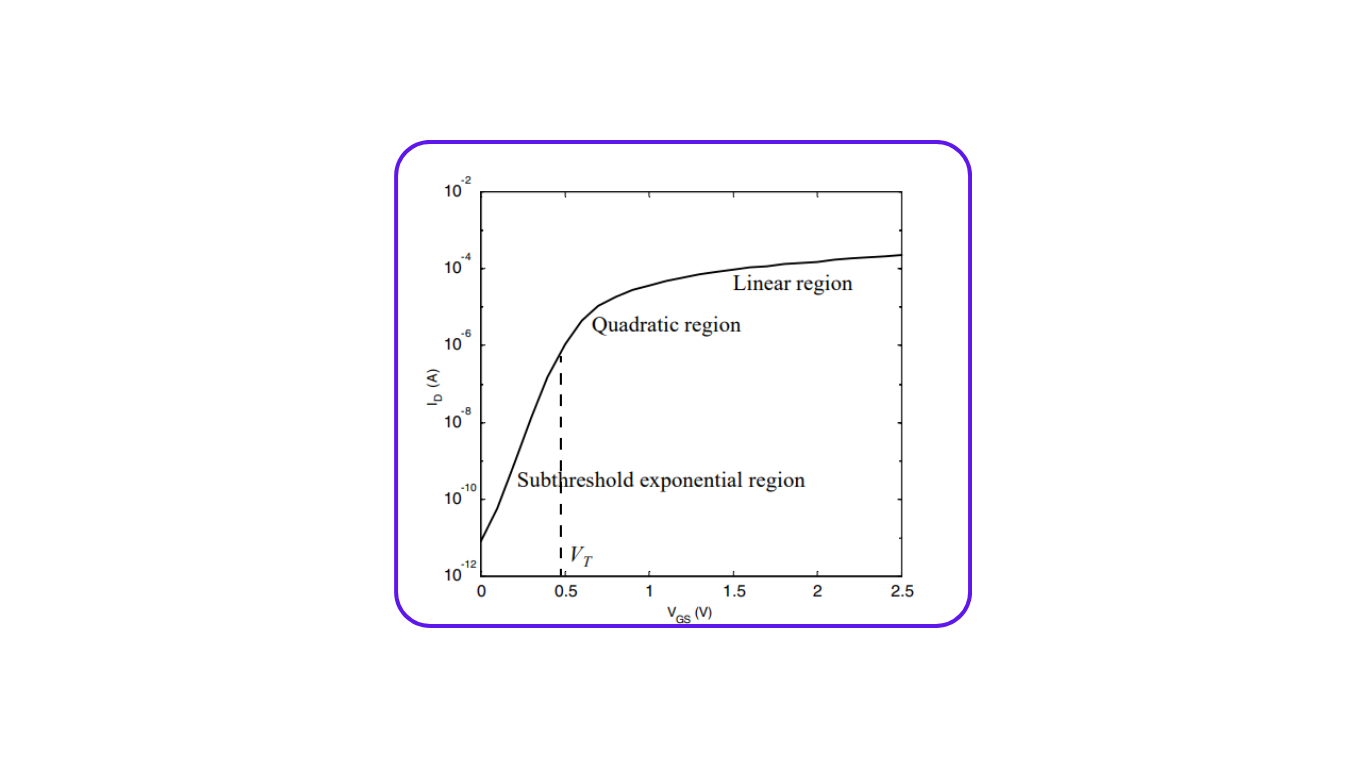Subthreshold Conduction
Subthreshold Conduction is a phenomenon observed in MOS (Metal-Oxide-Semiconductor) transistors where a small amount of current flows through the transistor even when the gate-source voltage (VGS) is below the threshold voltage (VT) required for strong inversion and full conduction. This subthreshold current flow occurs at gate-source voltages below VT but is considerably smaller than the current when the transistor is in the on-state.

Key points about subthreshold conduction
Gradual Transition: Subthreshold conduction leads to a gradual transition from the on-state to the off-state of the transistor. Even when the gate-source voltage is slightly below VT, some current can still flow through the transistor.
Exponential Decay: When observing the ID-VGS (drain current vs. gate-source voltage) curve on a logarithmic scale, it becomes evident that the current decreases exponentially as VGS decreases below VT. This behavior is similar to that of a bipolar transistor.
Parasitic Bipolar Transistor: In the absence of a conducting channel in the MOS transistor, the n+-p-n+ structure (source-bulk-drain) forms a parasitic bipolar transistor. The subthreshold current can be approximated using an empirical equation involving parameters IS and n, with n typically around 1.5.
Quality Measure: In digital applications, subthreshold current is often undesirable because it prevents the transistor from behaving like an ideal switch. The rate of current decline with respect to VGS below VT is measured by the slope factor S. A sharper current drop, corresponding to a smaller S value, is desirable. For ideal transistors, S is 60 mV/decade at room temperature, but real devices with n > 1 exhibit a less sharp drop.
Temperature Sensitivity: Subthreshold current and the slope factor S are influenced by temperature. As the operating temperature increases, the current roll-off becomes less sharp. Therefore, managing subthreshold current is crucial in designing integrated circuits, especially those operating at elevated temperatures.
In summary, subthreshold conduction in MOS transistors leads to a gradual current transition as the gate-source voltage decreases below the threshold. Achieving minimal subthreshold current is essential, particularly in applications where low leakage and precise control of transistor behavior are critical, such as dynamic circuits.
What is subthreshold or weak-inversion conduction in a MOS transistor?
Subthreshold or weak-inversion conduction refers to the phenomenon where the MOS transistor conducts current for gate-source voltages below the threshold voltage (VT). It is important to study because it affects the transistor’s behavior at low voltage levels and can impact the performance of digital circuits.
How does the transition from the on- to off-condition in a MOS transistor with decreasing gate-source voltage differ from an ideal switch-like behavior?
The transition is gradual rather than abrupt. The current in the transistor decays exponentially as the gate-source voltage decreases below VT, which is unlike the ideal switch-like behavior where the current would drop to zero immediately.
Why is the presence of subthreshold current undesirable in most digital applications?
Subthreshold current is undesirable because it detracts from the ideal switch-like behavior of MOS transistors. In digital applications, it’s essential for the current to drop rapidly when the gate-source voltage falls below the threshold voltage to ensure accurate and efficient circuit operation.